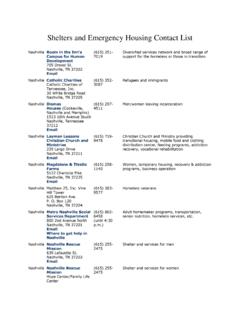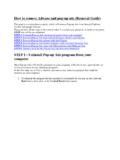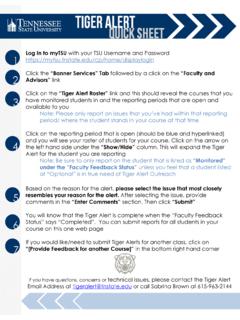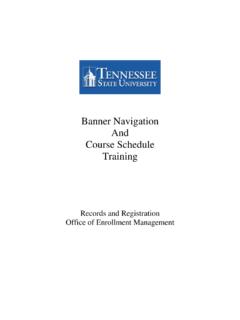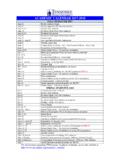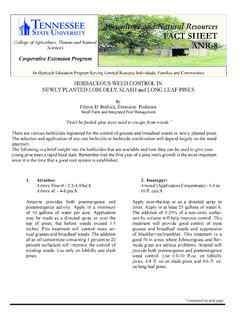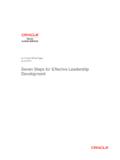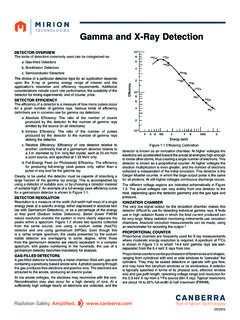Transcription of Characteristics of the Effective Leader
1 Characteristics of the Effective Leader By Marilyn Vojta, The true task of leadership involves the ability t o make change happen. Although multitudes of research has been done on what makes an Effective Leader , there appears to be no guaran teed consensus. Essentially outstanding leaders become a fine balance between traits, abilities, behaviors, sources of power, and aspects of the situation. These become the determining factors of the ability to influence followers and accomplish group objectives. Therefore, any member of any group, at any one time, may assume a leadership role, given any degree of innate traits and the circumstances surrounding t he event. Differen t people who can effectively influence what the group does, how it is done and t he method by which the group relates to one another could carry out various leadership functions. The most Effective measure of a Leader and his/her competency is the ex tent t o which the group at tains its goals.
2 It is easy to see why Stephan Covey, author of The 7 Habits of Highly Effective People, said Begin with the end in mind." Formulate an idea and then work t hrough the details so as to commit every t hought, feeling, and emotion knowing that you can portray it with confidence and honesty. It incorporates at titudes, values and a mindset that can facilitate commit ment and transformation. Leadership begins by developing a vision, a desire or picture of how an organization will look in the future. Often it represents an idea or dream of what might be or could be. It's the classic "If " statemen t. A Leader is capable of taking t his "if " and bringing it to life. In reality, a vision deno tes the "what" and the Leader represen ts the "how" or the elemen ts of what needs to be done to achieve the vision. Effective leadership begins with the fundamen tal ability to believe in yourself. It incorporates a maturity, conviction, and expertise that translates into a purpose and direction.
3 It is this clarity of vision that gives great leaders the confidence to adopt the rol e of instilling mo tivation, self-esteem, and teamwork. As visionaries, they are disciplined thinkers and confidently trust their in tuition. Leaders under-stand fully their environmen t and can transform situations to at tain an established vis io n. Leaders can combine change with growth, take prudent risks, and demonstrate considerable problem solving abilities. They believe in people, are sensitive to o ther's needs and appreciate a person's core values. They will actively remake a challenge to yield productive outcomes by creating an organization that develops and fosters success. Although often debated, leadership traits can be learned skills that with encouragemen t and reinforcemen t can produce outstanding individuals. T o understand the behavior and traits of a Leader , one needs to look at their innate Characteristics . Most significant are energy level, physical stamina and stress tolerance.
4 High energy and stress tolerance help to deal with the fast pace and often chao tic events of today's business. Leadership brings unrelen ting demands that require physical vitality and a high degree of emo tional resilience. Second, it requires the ability to problem solve and draw out those to creatively resolve issues along the way. One needs to be flexible with ideas and open to a variety of solutions and viewpoints. The key is to "see the forest through the trees" and have the ability to effectively meander through a variety of circumstances and obstacles, but to keep focused on the vision. As Warren Benis has stated lack of a clear vision is a major reason for the declining effectiveness of a Leader . No mat ter what the situation, leaders need to be able to communicate t heir ideas clearly and commit themselves to the outcome. A Leader must be able to transform his vision to a more inclusive position by gaining the trust and commit men t of those needed to fulfill his objective.
5 Once formulated, the vision represen ts a direction and must be reinforced by consisten t and reliable actions of the Leader . Gaining commit ment of those individuals, who will participate in the process of changing and growing an organization, requires that they must be emboldened by the task. If the Leader is unable t o get the commitmen t of others and can only achieve compliance, the ability to achieve success greatly diminishes. Leaders also need the confidence to build self-esteem in others and still main tain a strong degree of in tegrity in themselves. Wi th this comes the ability to influence an organization up, laterally and below as well as internally and externally. One must be able to gain the approval of everyone involved to make an idea reality. The ability to develop cooperative relations, to be a team player and to create an atmosphere that supports a high degree of collegiality, marks the true Leader . Leadership is further challenged by the ability to mo tivate o thers, often over a long period of time, and guide o thers effectively.
6 Peter Drucker stated, Management is doing things right; leadership is doing the right things. The right in managemen t terms comes from the in teraction with others. Leadership is never an individual s directing, it s a cooperative effort fostered by listening, gathering a variety of opinions, considering Effective strategies and effectively generating a clear vision. The literal definition of leadership is t he behavior of an individual when he is directing the activities of a group with a focus on a shared goal. It is the process of influencing" the activities of an organized group t oward goal achievemen t, as well as, the process of giving meaningful direction to collective efforts and achieving your objective. Although t here are thousands of documen ted definitions of what leadership is, it essentially always incorporates the ability to influence individuals with the objective of achieving an in tended goal. A Leader needs to achieve tough, demanding goals t hat he set himself in addition to those set by an organization, and focus on surpassing both objectives.
7 As importan t as flexibility con-tributes to this equation of leadership, it is importan t to sustain an en trepreneurial spirit. When commit men t is reached by leadership, it means that individuals agree with the idea and will make the greatest effort to execute effectively. T he process of mobilizing commit ment must be generated early and with a clear understanding t hat involvement is critical to success. This dedication is coupled closely with trust, a vital link to achievement within the organization. T rust is indirectly proportional to risk. To increase trust, leaders must decrease risk. Leadership depends on minimizing risk to ensure t hat the trust factor is solid. As a Leader , the ability to main tain high levels of trust comes t hrough consistent actions, honesty, expertise, confidence and clarity. Probably most significan t is the dedication to values that are exhibited by t he Leader 's own behavior and the method by which one reinforces behaviors in o thers.
8 Undoubtedly, successful leaders are in telligent enough to understand the needs of others, know t he necessity of commi tmen t, be energetic, possess the courage of conviction, and have an innate integrity. What can be expected of o thers is nothing less than what can be expected of yourself. Although leadership has many definitions and varied criteria for success, it is defined by the assumption that it is an influence process that in many cases is situational. The success of a Leader depends on his/her ability to achieve a goal t hrough the actions of those involved. It takes t he commitmen t of others in the organization to implement a Leader 's vision and goals. Society and organizations must have Effective leadership in order to successfully achieve their objectives. But primarily because it is vital for growth and the overall well being of our society. We must also remember that leadership needs to be constan tly developed, reinforced and be able to effectively foster commitmen t within an organization.
9 Vojta & Associates Consultants in Human Performance Management TargetYou - a technology-based retention strategy tool Stamford, CT 06902 203 357 8022

